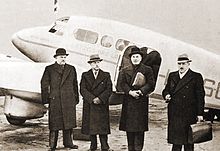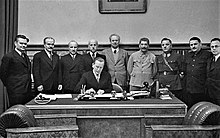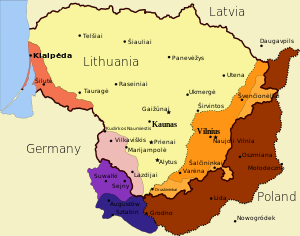Soviet–Lithuanian Mutual Assistance Treaty
| Part of a series of articles on the |
| Occupation of the Baltic states |
|---|
 |
The Soviet–Lithuanian Mutual Assistance Treaty (
Background
Pre-war treaties

Lithuania
On August 23, 1939, the Soviet Union and Nazi Germany signed the
World War II
On September 1, 1939,
Negotiations
Initial stance
On September 29, the next day after the Boundary and Friendship Treaty, Germany canceled planned talks with Lithuania and the Soviet Union informed Lithuania that it wished to open negotiations regarding future relationship between the two countries.[14] The new Soviet–Lithuanian negotiations were supposed to formally resolve the status of the Vilnius Region.[9] Lithuanian Minister of Foreign Affairs Juozas Urbšys arrived in Moscow on October 3. During the meeting Joseph Stalin personally informed Urbšys about the Soviet–German secret protocols and showed maps of the spheres of influence.[15] He demanded that Lithuania signed three separate treaties, according to which:[16]
- military bases would be established and up to 50,000 Soviet soldiers would be stationed in Lithuania (the original mutual assistance pact);
- Lithuanian territory west of the Šešupė Riverwould be ceded to the Nazi Germany (as agreed between Germany and Soviet Union in the Boundary and Friendship Treaty);
- one portion of the Vilnius Region would be attached to Lithuania.
Urbšys' protested the Soviet bases arguing that it would mean virtual occupation of Lithuania.[14] Soviets argued that their army would protect Lithuania from possible attacks from Nazi Germany and that a similar treaty was already signed with Estonia. Urbšys argued that Lithuania's neutrality was enough to guarantee its security and proposed to strengthen Lithuanian army.[16] According to the Lithuanian brigadier general Musteikis, Urbšys said that Lithuanians refused Vilnius Region as well as the Russian garrisons, however then nervous Stalin replied that "No matter if you take Vilnius or not, the Russian garrisons will enter Lithuania anyway".[17] Finally, the Soviets agreed to reduce the number of troops to 35,000.[14] Urbšys then also bargained for more territories in the Vilnius Region, especially in the vicinity of Druskininkai and Švenčionys, territories with larger Lithuanian populations.[16] The Soviets replied that the boundary draw by the 1920 peace treaty was inaccurate and that Belarusians also laid claims to the territory.[14] The Soviets tentatively agreed that territories where a Lithuanian majority could be proven would be transferred to Lithuania.[16] Nevertheless, the Soviets blackmailed the Lithuanians that if they will not accept the Mutual Assistance Treaty, Vilnius will be attached to the Byelorussian Soviet Socialist Republic.[18] The most shocking demand was to cede part of Lithuanian territory to Germany.[14] Lithuanians decided to postpone any negotiations regarding territory transfer to Germany until Germans expressed clear demands.[14]
Acceptance


Urbšys returned to Lithuania to consult the government. German officials confirmed that the secret protocols were real, and informed Lithuanians that transfer of the territory in Suvalkija was not an urgent matter.[14] Eventually, Nazi Germany sold this territory to the Soviet Union for 7.5 million dollars on January 10, 1941, in the German–Soviet Border and Commercial Agreement.[19] Lithuanians in principle agreed to sign the mutual assistance treaty, but were instructed to resist Soviet bases as much as possible. Alternatives included doubling the Lithuanian army, exchanging military missions, and building fortifications on the western border with Germany similar to the Maginot Line in France.[16][20] On October 7, Lithuanian delegation, including General Stasys Raštikis and Deputy Prime Minister Kazys Bizauskas, returned to Moscow.[16] Stalin refused the proposed alternatives, but agreed to reduce the number of Soviet troops to 20,000 – about the size of the entire Lithuanian army.[9] Soviets wanted to sign the treaty right then to commemorate the 19th anniversary of Żeligowski's Mutiny and Lithuania's loss of Vilnius.[14] Political rallies, organized in Vilnius demanding city's incorporation into the Byelorussian Soviet Socialist Republic, put additional pressure on Lithuanians and provided a sense of urgency.[9][14] Urbšys refused to sign and the talks receded for the second time.
In Lithuania, President
Provisions

Articles of the treaty
The mutual assistance treaty contained nine articles:[22]
- Article I: Transfer of Vilnius Region and the city of Vilnius to Lithuania
- Article II: Mutual assistance in case of an attack
- Article III: Soviet Union renders assistance to the Lithuanian Army in terms of munitions and equipment
- Article IV: Soviet Union receives right to station its troops in Lithuania. Base locations are to be decided by a separate treaty.
- Article V: Coordinated actions in case of an attack
- Article VI: Agreement not to participate in alliances against the other party
- Article VII: Sovereignty is not affected by this treaty
- Article VIII: Articles II to VII are valid for a period of 15 years with an automatic extension for another 10 (note that transfer of Vilnius is permanent)
- Article IX: Date of effect
The treaty also had a secret supplement, which specified that the Soviets could station only up to 20,000 of their troops.[23]
Location of Soviet troops
The treaty did not decide the exact location of the Soviet bases and 18-member Soviet delegation, led by Mikhail Kovalyov, was sent to Lithuania to discuss the specifics on October 22.[24] The Lithuanians sought to limit Soviet bases to Vilnius Region and southern Lithuania, offering Pabradė, Nemenčinė, Naujoji Vilnia, and Alytus.[25] They considered a base in Samogitia (western Lithuania) to be the worst possible outcome.[25] The Lithuanians preferred fewer, but bigger bases with no permanent runways for the aircraft. The Soviets initially proposed to have their bases in Vilnius, Kaunas, Alytus, Ukmergė, and Šiauliai.[25] The final agreement was signed on October 28, the same day when the Lithuanian army marched into Vilnius. A day before, another agreement determined the new border of eastern Lithuania: Lithuania received 6,739 km2 (2,602 sq mi) of territory with population of approximately 430,000.[16] The territory comprised about one fifth of the Vilnius Region recognized to Lithuania by the Soviet–Lithuanian Peace Treaty of 1920; population of Lithuania reached about 3.8 million.[26]
According to the final agreement, four military bases would be established in Lithuania with 18,786 military personnel from the 16th Special Rifle Corps, 5th Rifle Division, and 2nd Light Tank Brigade.[27] The bases were to be located in Alytus (infantry, artillery, and mechanized units with 8,000 troops), Prienai (infantry and artillery units with 2,500 soldiers), Gaižiūnai (mechanized and tank units with 3,500 troops), and in Naujoji Vilnia (headquarters, infantry and artillery units with 4,500 troops).[25] For comparison, on June 1, 1940, Lithuanian army had 22,265 soldiers and 1,728 officers.[28] While aircraft bases in Alytus and Gaižiūnai were under construction, Soviet aircraft were to be stationed in Kirtimai, a neighborhood of Vilnius.[25] The final location of the bases showed that the Soviets were more concerned with encircling Kaunas, the temporary capital, than with defending the country against a possible foreign attack.[25]
Aftermath
International and domestic reaction
The treaty was presented as proof of Soviet respect for small nations[29] and Stalin's benevolence by Soviet propaganda.[1] Russians emphasized that it was the second time the Soviet Union gave Vilnius to Lithuania[21] while the League of Nations failed to mediate the Polish–Lithuanian dispute.[30] The Soviets also worked to assure Lithuanians that Soviet friendship is effective protection from and a welcome alternative to Nazi aggression.[14] The Polish government-in-exile officially protested the treaty as it did not recognize Russian conquest and claimed sovereignty over territories of the Second Polish Republic.[31] Lithuanians replied that the region was legally part of Lithuania.[32] Poles resented the transfer and as soon as the Soviet Army left Vilnius, anti-Lithuanian riots broke out accusing Lithuanians of betrayal.[33] France and Great Britain, traditional allies of Poland, also condemned the treaty.[14][16] Belarusian activists who campaigned for Vilnius incorporation into the Byelorussian Soviet Socialist Republic were arrested, deported, or executed by the Soviet authorities. The transfer upset their national aspirations to position Belarus as a successor to the former Grand Duchy of Lithuania.[32] Lithuanian relations with the Vatican were expected to improve as the cause for tension, the Vilnius Region assigned to Poland by the Concordat of 1925, now was under Lithuanian control.[34]
Lithuanian politicians attempted to show the regained Vilnius as a major diplomatic victory. The
In Vilnius Region

| External videos | |
|---|---|
| Documentary for the annexation of Vilnius | |
On October 28, the Lithuanian Army entered Vilnius for the first time since 1920. Before handing over the city to the Lithuanians, the Soviets robbed and transported to the Soviet Union all valuables: equipment from factories (including Elektrit) and hospitals, vehicles and trains, cultural objects from museums and libraries.[25] After the Russian troops left, Polish residents, seeing the deal as a betrayal of Poland, protested against the Lithuanian government.[33] On October 30 – November 1, when the bread price suddenly rose, clashes between local communists and Poles turned into a riot against the Jewish population.[35] Many Jewish shops were raided and some 35 people were injured.[36] Jews accused Lithuanian police of inaction and sympathizing with Polish rioters.[36] Soviet soldiers, uninvited by the Lithuanian government, helped to subdue the riots.[27]
The territory presented an economic challenge to Lithuania: unemployment was rampant, food was in short supply, valuables were stolen by the Soviet army, war refugees were gathering from other former Polish territories.[26] The Lithuanian army would provide up to 25,000 daily rations of hot soup and bread to residents of Vilnius. The Lithuanian government exchanged the Polish złoty to Lithuanian litas at a favourable rate, losing over 20 million litas.[26][37] The Lithuanian government decided to implement a land reform similar to the land reform executed in the 1920s.[37] Large estates would be nationalized and distributed to landless peasants in exchange for redemption dues payable in 36 years. Politicians hoped that such reform would weaken pro-Polish landowners and would win peasants' loyalty to the Lithuanian state. By March 1940, 90 estates and 23,000 hectares were distributed.[37] Lithuanians proceeded to "re-Lithuanize" cultural life in Vilnius Region. They closed many Polish cultural and educational institutions, including Stephan Batory University with over 3,000 students.[33] Lithuanians sought to introduce the Lithuanian language in public life and sponsored Lithuanian organizations and cultural activities.
In Lithuania
Future of the Vilnius Region caused frictions between political and military leaders in Lithuania. As the first Soviet troops moved into Lithuania on November 14, the government, which included four generals, resigned.
After months of intense propaganda and diplomatic pressure, the
See also
- Soviet–Estonian Mutual Assistance Treaty
- Soviet–Latvian Mutual Assistance Treaty
- Polish National-Territorial Region
References
- ^ a b "Soviet Acclaimed Baltic's Protector". The New York Times: 5. 1939-10-12.
- ^ ISBN 0-415-26731-5.
- ^ Gedye, G.E.R. (1939-10-03). "Latvia Gets Delay on Moscow Terms; Lithuania Summoned as Finland Awaits Call to Round Out Baltic 'Peace Bloc'". The New York Times: 1, 6.
- ^ Miniotaite, Grazina (1999). "The Security Policy of Lithuania and the 'Integration Dilemma'" (PDF). NATO Academic Forum. p. 21.
- ISBN 0-312-22458-3.
- ISBN 0-8179-2852-9.
- ISBN 9986-9216-9-4. Archived from the originalon 2008-03-03. Retrieved 2008-03-14.
- ISBN 978-90-420-2225-6.
- ^ ISBN 5-430-01059-6.
- ISBN 978-1-59420-123-3.
- ^ ISBN 0-8133-1839-4.
- ISBN 978-90-420-2225-6.
- ^ ISBN 0-7391-0534-5.
- ^ ISBN 978-90-420-2225-6.
- ISSN 0024-5089.
- ^ ISBN 0-312-22458-3.
- ^ Gureckas, Algimantas. "Ar Lietuva galėjo išsigelbėti 1939–1940 metais?". lrytas.lt (in Lithuanian). Archived from the original on 15 January 2020. Retrieved 30 June 2010.
- ^ "Sovietų kariuomenė Vilniaus krašte 1939–1940 m. (iki Lietuvos okupacijos)". KGBveikla.lt (in Lithuanian). Retrieved 12 November 2023.
- ISBN 5-415-01502-7.
- ^ Gedye, G.E.R. (1939-10-07). "Lithuania to Yield: Will Give Soviet Union Right to Build 'Maginot Line' on German Border". The New York Times: 1, 7.
- ^ ISBN 978-90-420-2225-6.
- ISBN 81-7488-491-2.
- ^ ISBN 0-253-33600-7.
- ^ Gedye, G.E.R. (1939-10-23). "Russians Solicit Estonians' Favor". The New York Times: 6.
- ^ ISSN 0001-6829.
- ^ ISBN 9986-9216-9-4. Archived from the originalon 2008-03-03. Retrieved 2008-11-02.
- ^ ISBN 9986-757-65-7.
- ISBN 978-5-420-01639-8.
- ISBN 0-8047-0122-9.
- ^ ISBN 978-90-420-2225-6.
- ^ "Poles Bar Cession of Any Territory". The New York Times: 3. 1939-10-21.
- ^ ISBN 0-300-10586-X.
- ^ ISBN 0-7864-0371-3.
- ^ Matthews, Herbert L. (1939-10-19). "Pope Will Defend Christian Europe". The New York Times: 10.
- ^ "40 Russian Tanks are Sent to Vilna". The New York Times: 2. 1939-11-02.
- ^ ISBN 9986-780-70-5.
- ^ ISBN 0-253-33600-7.
- ^ "First Soviet Troops Move into Lithuania". The New York Times: 3. 1939-11-15.
- ^ "Kaunas Mayor Forms Lithuanian Government". The New York Times: 2. 1939-11-21.
- ISBN 0-8047-0587-9.
